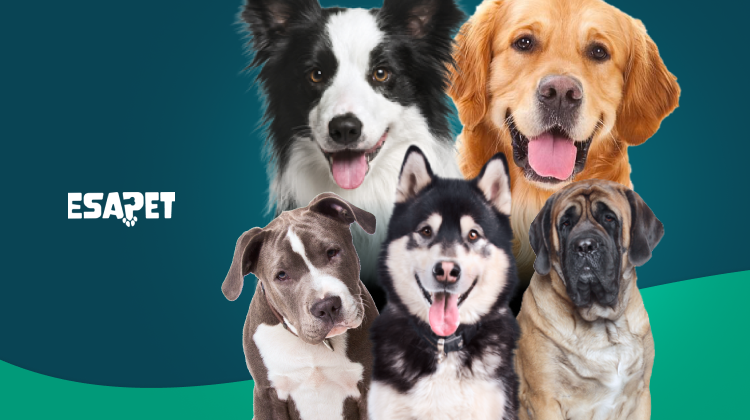Best Psychiatric Service Dog Breeds for Mental Health Support

PSDs offer crucial support for individuals with PTSD, anxiety, and depression through specialized tasks. Choosing the best psychiatric service dog breeds is essential for matching the right dog to specific mental needs. Read on to discover which breeds are right for you.
Service Dogs and Their Roles
Service dogs assist people with disabilities by performing tasks based on the handler’s needs. There are multiple types of service dogs. These include guide dogs for the visually impaired, mobility dogs for those with physical disabilities, and PSDs for individuals with mental issues.
PSDs focus on supporting individuals with mental health conditions. These dogs perform specific tasks, such as providing deep pressure therapy during anxiety episodes, reminding their handler to take medication, and offering emotional support during panic attacks.
Great psychiatric service dogs also interrupt harmful behaviors or signal their handler to leave stressful situations. The dog and handler work together closely, building a strong bond of trust. This partnership helps people regain control over their lives, ensuring greater independence.
Best Psychiatric Service Dog Breeds
The best service dog breeds for psychiatric work have a calm temperament, intelligence, and trainability. These qualities are essential for helping individuals with mental health conditions.
Some breeds excel in psychiatric roles due to their quick learning and support. These dogs help manage anxiety, panic attacks, and other challenges. Let’s learn about each breed and why they are perfect for psychiatric service work.
 |
Labrador RetrieverLabrador Retrievers are ideal for psychiatric service work. Their calm temperament, intelligence, and high trainability make them a top choice. Labradors are patient and responsive, excelling at performing tasks like deep pressure therapy. |
 |
Golden RetrieversGolden Retrievers are a top breed for psychiatric service dog tasks. They are known for their friendly nature, loyalty, and intelligence. They learn quickly and can perform many tasks. These include offering emotional support and sensing anxiety. |
 |
German ShepherdsGerman Shepherd dogs are highly trainable and dependable. Due to their strong focus and loyalty, they are often chosen for psychiatric service roles. These dogs are helpful in public spaces, providing physical and emotional support. |
 |
Cavalier King Charles SpanielsCavalier King Charles Spaniels are gentle, affectionate dogs that excel at offering emotional support. Their small size and loving nature make them popular PSDs. They form strong bonds with their handlers, helping to ease stress and anxiety. |
 |
PoodlesPoodles, particularly Standard Poodles, are great for psychiatric service work. Their intelligence allows them to learn complex tasks, while their hypoallergenic coats make them suitable for individuals with allergies. Poodles have a calm demeanor. |
 |
Bernese Mountain DogsBernese Mountain Dogs are known for their calm, strong nature. These qualities make them excellent service dogs for individuals who need physical support. Their calm presence helps reduce anxiety and provide emotional stability. |
Best Psychiatric Service Dog Breeds for Specific Conditions
Different psychiatric conditions require specific support, and certain breeds are better suited for these tasks. These dogs offer emotional comfort and assist individuals in daily life. Matching the right breed to a condition is crucial for effective support.
Each breed has unique strengths. Some help with anxiety and depression, while others assist with autism or mobility needs. Let’s explore which breeds are best for each condition.
Best Psychiatric Service Dog Breeds for Anxiety and Depression
Individuals with anxiety and depression need dogs that offer comfort and calmness. The following breeds are excellent at providing emotional support and stability:
- Labrador Retriever
- Golden Retriever
- Cavalier King Charles Spaniel
- Poodle
Best Psychiatric Service Dog Breeds for Autism Spectrum Disorder (ASD)
Dogs that assist individuals with ASD need to be patient, attentive, and calm. These breeds are highly effective for individuals with ASD:
- Labrador Retriever
- Golden Retriever
- Poodle
- German Shepherd dog
Best Psychiatric Service Dog Breeds for Mobility Assistance
Some psychiatric service dogs also assist with mobility. These dogs are strong and reliable. They help with tasks like supporting balance and retrieving items. A good service dog for mobility combines strength with a calm nature. Here are the best breeds for this role:
- Bernese Mountain Dog
- Golden Retriever
- German Shepherd
Best Psychiatric Service Dog Breeds for Seizure Alert
Certain breeds are trained to detect and respond to seizures for individuals with seizure disorders. These dogs are highly reliable for seizure alert tasks:
- Labrador Retriever
- Poodle
- German Shepherd
Best Psychiatric Service Dog Breeds for Flying/Travel
Flying with a PSD requires careful breed selection. Size, temperament, and behavior in confined spaces matter. Small breeds are easy to manage in tight spaces, while calm, larger breeds can still provide strong emotional support.
The dog must stay relaxed in busy airports and crowded airplane cabins. Training is essential for travel. Service dogs must handle public spaces calmly and follow commands. Airlines have specific rules for service dogs. Let’s learn more in the following sections.
- Small Breeds for Flying: Poodles (Toy or Miniature), Cavalier King Charles Spaniels, Miniature Schnauzers, Shih Tzus, Yorkshire Terriers
- Calm and Larger Breeds: Labrador Retriever, Golden Retriever, Bernese Mountain Dog, Standard Poodle, Greyhound
Understanding legal protection is essential when flying. The Department of Transportation (DOT) enforces the ACAA, allowing service dogs to fly with their handlers. Airlines may request documentation. Proper training ensures the dog behaves and follows commands in planes.
Best Psychiatric Service Dog Breeds for Public Access
Some dog breeds are naturally suited for handling public environments. This is due to their calm behavior and adaptability. They remain steady in crowded or noisy areas. This helps their handlers feel safe and comfortable.
- Golden Retriever: Known for their calm nature. They adapt well to busy public spaces without stress.
- Labrador Retriever: Dependable and focused. They stay attentive even in chaotic environments.
- Poodle: Highly intelligent. Poodles can easily adjust to public spaces, responding quickly to commands.
Best Psychiatric Service Dog Breeds for Housing
Choosing a PSD involves considering size, behavior, and shedding for apartment living. These breeds don’t take up too much space or cause issues like shedding.
Below are some characteristics to look for when choosing an apartment-friendly PSD. The ideal dog should remain calm indoors, adapt well to smaller spaces, and need minimal grooming.
- Small to Medium Breeds for Apartments: Cavalier King Charles Spaniel, Miniature Schnauzer, Poodle
- Low-Shedding, Hypoallergenic Breeds: Poodle, Miniature Schnauzer, Bichon Frise
Apartment-friendly breeds can provide essential psychiatric support without taking up much space. This makes them ideal for housing. Low-shedding breeds reduce the risk of allergies. This allows handlers to enjoy their support without concerns about space limitations.
Uncommon Psychiatric Service Dog Breeds
Several lesser-known breeds are well-suited for psychiatric service work. Their unique traits make them exceptional for emotional and psychiatric support. Here are some of the lesser-known breeds:
- Border Collie: This breed excels at learning complex tasks. They help maintain focus for extended periods.
- American Staffordshire Terrier: Strong and loyal. They offer both emotional and physical support for their handlers.
- Mixed Breeds: These have the right temperament for service work. They can be trained to meet specific psychiatric needs.
Service Dog Selection Criteria
Choosing a service dog is an important decision that involves several factors. The dog should fit the handler’s emotional and physical needs well. Selecting a dog that can form a strong bond with its handler is very important to ensure effective support.
A good service dog can stay calm and focused in different environments, from quiet homes to busy public spaces. The breed’s natural traits should align with the handler’s lifestyle and the challenges they face every day.
Below are some of the most important factors to keep in mind. These three factors will guide you in selecting the perfect companion for your needs.
Temperament and Suitability
Temperament is crucial when selecting a PSD. Breeds that are naturally calm, attentive, and able to handle stress are ideal. These dogs must stay composed in busy or stressful environments.
Health Considerations
Health should be a top priority when choosing a service dog. Dogs with fewer health issues are more likely to serve for many years. Breeds prone to health problems may be unable to perform their tasks reliably. Regular vet check-ups and preventive care help maintain longevity.
Matching Breeds with Handler Needs
Different breeds excel at different tasks. It’s very important to match the breed with the handler’s specific needs. Some dogs are better at providing emotional support, while others may excel at physical tasks like retrieving items.
Genetic Testing and Health Screening for Service Dogs
Genetic testing and health screening are essential when choosing a service dog. These tests check for any health problems the dog might inherit from its parents. Ensuring the dog is healthy helps it perform its service tasks without issues.
Performing these tests early allows breeders and handlers to select strong and reliable dogs. This ensures the dog stays healthy and offers dependable support for many years. It’s a key step in making sure the dog is fit for the job.
Importance of Genetic Testing for Service Dogs
Genetic testing helps identify conditions that could affect a dog’s ability to perform service tasks in the long term. Issues like hip dysplasia, progressive retinal atrophy (PRA), and cardiac problems can severely limit a dog’s ability to serve.
Common Genetic Tests for Service Dog Breeds
Genetic tests are crucial for identifying hereditary health issues in service dog breeds. These screenings ensure the dog’s health and suitability for service work. Common genetic tests for service dog breeds include:
- Hip and elbow dysplasia screening
- DNA tests for progressive retinal atrophy (PRA)
- Heart disease screening
- Genetic markers for breed-specific issues
Health Screening in Service Dog Selection
General health screenings are vital for service dog selection. Veterinary exams, blood tests, and orthopedic assessments ensure the dog is fit. These tests confirm the dog’s physical readiness for service. They help handlers choose dogs that will provide reliable support for the long term.
Breeding Practices for Service Dogs
Breeding service dogs requires selecting pairs. These key traits, intelligence, calm temperament, and trainability, are very important. Choosing dogs with these qualities increases the likelihood of producing puppies well-suited for service work.
The selection process focuses on proven traits. Breeders look for dogs with strong work ethics, adaptability, and low reactivity to stress. These traits are passed down to the puppies, making them reliable for service roles. Breeding with these traits ensures the success of service dog programs.
Selecting Breeding Pairs for Service Traits
Selecting breeding pairs involves more than just physical health. Intelligence, calmness, and trainability are essential traits. A good service dog must be able to handle stressful environments without becoming reactive.
Strong temperament and high trainability are important. A service dog needs to learn quickly and follow commands. Dogs with these traits are more dependable in service roles. Breeders rank these qualities when selecting pairs to produce the next generation of service dogs.
Breeding for Specific Service Dog Roles
Selective breeding helps ensure that dogs have the traits needed for specific service roles. Different tasks need unique qualities. Breeders focus on these traits to match dogs with the roles for which they are best suited. This approach improves the dog’s ability to perform tasks.
- Guide Dogs: Bred for focus, adaptability, and a steady temperament. These traits help guide dogs to stay calm and alert in different environments.
- Psychiatric Service Dogs: Bred for calmness and emotional intelligence. This ensures they can provide comfort and emotional support in stressful situations.
- Mobility Assistance Dogs: Bred for strength and physical support. These dogs help handlers with tasks like balancing and retrieving objects.
Rescue Dogs as Service Dogs
Rescue dogs can also be trained as service dogs. While they aren’t bred for specific traits, many rescue dogs have the intelligence and temperament needed for service roles. Training these dogs gives them a second chance at life.
Adopting rescue dogs for service roles benefits shelters and handlers. It reduces overcrowding in shelters and gives dogs a new purpose. Some rescue dogs, including mixed breeds, perform well in service roles. Their eagerness to learn makes them valuable additions to service programs.
Advantages of Using Rescue Dogs for Service Work
Rescue dogs bring unique benefits to service work. Training them gives abandoned or neglected dogs a fresh start. Many rescue dogs possess qualities like intelligence, loyalty, and focus. Handlers who work with rescue dogs often find them to be motivated and dedicated.
Training rescue dogs also creates a deep bond between the dog and the handler. Giving a dog a second chance through service work strengthens this connection. Rescue dogs are often eager to please and ready to learn. This makes them strong candidates for service roles.
Assessing Rescue Dogs for Service Dog Potential
Rescue dogs are assessed through temperament and behavior tests. Trainers look for calm, adaptable, and eager-to-learn dogs. The ability to adjust to new environments and follow commands is crucial. Dogs that show these qualities are good candidates.
Success Stories: Rescue Dogs as Service Dogs
One example is a rescue dog named Jake. He was adopted from a shelter and trained as a mobility service dog for a woman with multiple sclerosis. He now helps her with tasks like picking up dropped items and providing balance support.
Another success story is Bailey. A shelter dog who was trained as a psychiatric service dog for a veteran with PTSD. Through patience and professional training, Bailey now provides emotional support and helps his handler navigate stressful situations.
Service Dog Temperament Testing
These tests assess key behaviors to ensure the dog can handle stressful situations. Dogs are evaluated on how they respond to various stimuli, their attention levels, and their adaptability to new environments.
The tests focus on behaviors such as a dog’s ability to stay calm and focused. They also monitor a dog’s attention to its handler, adaptability in unfamiliar settings, and responses to loud noises.
Key Traits Assessed in Temperament Testing
Certain traits are crucial when evaluating a service dog’s temperament. These traits ensure the dog can handle service tasks and challenging environments. Temperament tests focus on the following key areas:
- Attention and focus: The dog can stay attentive during training sessions. A strong focus helps the dog consistently respond to the handler’s needs.
- Adaptability: How well the dog remains calm in new or stressful situations. Dogs must handle unfamiliar environments without becoming anxious or reactive.
- Response to stimuli: The dog’s reaction to distractions like loud noises, strangers, or sudden movements. A good service dog stays composed even when facing unexpected situations.
- Trainability: How quickly the dog learns and retains new tasks or commands. High trainability ensures the dog can master complex tasks and maintain reliability over time.
Standard Temperament Tests for Service Dogs
Common temperament tests include the Volhard Puppy Aptitude Test (PAT). This test measures a puppy’s response to different situations. Other industry-recognized tests test the dog’s behavior under stress, ability to focus, and responsiveness to training.
Assessing Long-Term Suitability for Service Work
Ongoing temperament testing ensures that dogs remain suitable for service as they grow. As dogs mature, they encounter new environments and challenges. Regular evaluations help confirm that the dog possesses the necessary traits for service work.
Managing Stress and Burnout in Service Dogs
Service dogs, like humans, can experience stress and burnout. Over time, the demands of assisting handlers can take a toll on the dog’s well-being. Handlers and trainers must recognize the signs of stress early. Recognizing burnout helps maintain a service dog’s long-term health.
Dogs under stress may lose interest in their tasks or become more anxious. Handlers need to watch for these signs and provide the necessary care. Taking steps to reduce stress helps service dogs remain enthusiastic in their work.
Identifying Signs of Stress and Burnout in Service Dogs
Service dogs can experience stress and burnout. It may affect their ability to perform tasks. It’s important to recognize early signs. Identifying these signs can help ensure the dog’s well-being and performance.
- Decreased enthusiasm for tasks
- Withdrawal from social interactions
- Increased anxiety or nervous behaviors
- Reluctance to engage in previously enjoyable activities
Strategies to Prevent Service Dog Burnout
Service dogs need a balance of work, play, and rest to prevent burnout. Incorporating relaxation periods and engaging in activities can help maintain their health. These strategies support their emotional well-being and overall effectiveness as service animals.
- Regular Breaks and Relaxation Periods
Allow your service dog to take breaks and have downtime. This helps prevent overwork and gives them a chance to rest and recharge. It ensures they stay healthy and enthusiastic. - Mental Stimulation Through New Tasks and Play
Introducing new tasks or playful activities can keep a service dog mentally engaged. Varying their routine helps prevent boredom and keeps their mind sharp, reducing stress. - Maintaining a Balanced Workload
It’s crucial to ensure your service dog has a balanced workload. This prevents them from feeling overwhelmed and promotes a sustainable, happy working relationship. - Ensuring Sufficient Physical Exercise
Physical exercise is essential for a service dog’s well-being. Daily walks, playtime, and outdoor activities help them release energy, stay fit, and improve their mood. This helps in reducing the risk of burnout.
Managing Stress for Long-Term Service Work
Managing stress is key to their long-term success. Consistent routines help the dog feel secure and confident. Regular training reinforcement keeps their skills sharp. Meeting the dog’s emotional and physical needs ensures they can support their handlers for years to come.
Life Expectancy and Retirement for Service Dogs
Most service dogs can work effectively for eight to ten years. After this period, they may start to show signs of aging and reduced performance. This is an indication of retirement. Retiring a service dog is a thoughtful process.
Handlers must consider the dog’s well-being and prepare for a transition to a new service dog. Replacing a service dog requires time and emotional preparation. The handler must adjust to the change while ensuring the new dog is properly trained and integrated.
Typical Working Life of a Service Dog
The average working life of a service dog is typically eight to ten years. This can vary based on the dog’s breed, health, and the intensity of its work. Smaller breeds may work longer, while larger dogs may retire sooner due to the physical strain.
Signs a Service Dog is Ready for Retirement
Handlers and trainers must watch for signs that the dog is ready for retirement. These signs include reduced mobility, increased fatigue, and difficulty performing tasks. The dog may also lose enthusiasm for work. Recognizing these signs can help you retire the dog at the right time.
Transitioning from a Retired Service Dog to a New Dog
Transitioning to a new service dog requires careful planning. The handler must be emotionally prepared to adjust to a new partner. Practical steps include training the new dog while phasing out the retired dog’s responsibilities.
Options for Retired Service Dogs
When a service dog retires, several options are available. Many handlers choose to keep the retired dog as a pet. Others may place the dog with a family member or a friend. Some retired service dogs are placed in specialized programs that care for aging or retired working animals.
Psychiatric Service Dogs (PSD) Roles and Responsibilities
PSDs assist individuals with mental health conditions. Their main responsibilities include performing specific tasks to help their handler manage challenges. For people with conditions like PTSD, anxiety, or depression, PSDs offer essential support.
They provide assistance that helps prevent panic attacks, emotional overload, and anxiety. PSDs are trained to perform tasks, reminding their handler to take medication or interrupting harmful behaviors. These psychiatric dogs are a lifeline for individuals dealing with mental disorders.
Differences Between Psychiatric Service Dogs and Emotional Support Animals (ESA)
Psychiatric service dogs and ESAs differ in key ways. PSDs are trained to perform tasks related to their handler’s disability. Unlike ESAs, PSDs have legal rights under the Americans with Disabilities Act (ADA). ESAs provide comfort but don’t have the same legal protections or training.
Psychiatric Service Dog Training
Training a PSD involves multiple stages. First, the dog must learn basic obedience commands like “sit,” “stay,” and “heel.” Public access training follows, teaching the dog to behave in busy environments. Then, the dog undergoes specialized training to help with their handler’s needs.
Specialized tasks include deep pressure therapy, panic attack intervention, and medication reminders. Psychiatric service dog training can take months or even years to ensure the dog is fully prepared. A well-trained psychiatric service dog is reliable in both private and public settings.
Where to Get a Psychiatric Service Dog
There are several ways to get a PSD. Accredited organizations often have trained dogs that are ready to meet specific needs. Private trainers also provide options, tailoring the dog’s training to the handler’s needs.
Some individuals choose owner-training, which involves training the dog themselves. Owner training requires time, commitment, and knowledge of training techniques. Accredited organizations or professional trainers can guide those who choose this path.
Psychiatric Service Dog Letter (PSD Letter)
To get a PSD, a letter from a licensed mental health professional is often required. This PSD letter confirms that the individual has a qualifying mental health condition. The letter is necessary for legal protection under the ADA. It verifies the need for the PSD.
A PSD letter differs from an ESA letter. While both confirm mental health conditions, the PSD letter grants the dog access to public places and housing under the ADA. ESA letters do not provide these legal rights.
Legal Rights and Responsibilities for Psychiatric Service Dog Owners
PSD owners have specific rights under the ADA. They are entitled to bring their service dogs into most public spaces where the public is allowed. Under the ADA, service animals are not pets and cannot be denied access based on “no pets” policies.
Service dog owners also have housing rights. Landlords are not allowed to discriminate or charge extra fees because of a service dog’s presence. PSD owners must make sure their dogs are under control in public. This means the dog must be harnessed, leashed, or tethered.
Owners also have responsibilities for their PSDs. These include supervising and caring for the dog, ensuring proper behavior, and meeting local animal licensing and vaccination requirements.
Public Access Rights Under the ADA
PSD owners can bring their service dogs into most public places. Under the ADA, businesses cannot deny access to service dogs, even if they have a “no pets” policy. The service dog must be allowed to go with its handler to any area where the public is allowed.
Housing Rights Under the Fair Housing Act (FHA)
The FHA allows PSD owners to live with their service dogs in any type of housing. Landlords are prohibited from charging extra fees for PSDs. The handler must ensure that the dog does not cause damage or disturbances.
Travel Rights Under the Air Carrier Access Act (ACAA)
The ACAA allows PSDs to go with their handlers during air travel, usually in the plane’s cabin. Airlines may need advance notice for service dogs to ensure proper accommodations. The dog must be well-behaved, and specific airline rules should be followed.
Responsibilities for Service Dog Behavior and Control
PSD owners are responsible for ensuring their dogs behave in public. The dog must be under control. If the service dog is not well-behaved or poses a safety risk, businesses may ask the handler to remove the dog.
Care and Supervision of the Service Dog
PSD handlers are expected to fully care for their service dog’s needs. This includes feeding, grooming, and veterinary care. Ensuring the dog’s well-being is key to maintaining its ability to provide support.
Licensing and Health Requirements
While service dogs are exempt from breed restrictions, they must still comply with local health laws. These laws include licensing and vaccinations. PSD owners should ensure their dogs are registered and meet all local health and safety requirements.
Service Dog Certification and Recertification
Certifying a PSD involves ensuring the dog is trained to perform tasks for its handler. The certification process includes verifying the dog’s training and behavior in public spaces. Working with a reputable trainer or organization is essential to ensure the certification is valid.
Over time, service dogs may need recertification to ensure they still meet the required standards. Regular training updates help the dog stay sharp and maintain its skills. Recertification may involve additional evaluations.
Financial Considerations for Psychiatric Service Dogs
Owning a PSD involves many costs. These include initial training and long-term care. The overall investment can be significant. However, the support provided by these dogs is invaluable.
Training a service dog requires time and money. These costs vary depending on the organization or trainer involved. Long-term care, such as veterinary visits, also adds to the expenses.
Fortunately, there are funding options available. Grants, non-profit organizations, and insurance plans may help cover these costs. Below are the key financial aspects to consider when planning for a PSD.
- Training Fees
Depending on the level of training required, fees can range from $10,000 to $30,000 or more. This includes basic obedience, public access training, and specific tasks for mental conditions. Many individuals work with certified service dog breeders or trainers. - Veterinary Care
Veterinary care for a PSD can cost around $500 annually for routine check-ups and basic care. However, costs can rise depending on the dog’s health needs and any treatments required. Some vets may offer discounts for service dogs, though this isn’t guaranteed. - Funding Options
Some grants, non-profit organizations, and insurance plans offer financial support for service dogs. These programs assist with both training and ongoing care.
Specialized Service Dog Equipment
PSDs require specialized equipment to perform their roles effectively. Service dog vests, harnesses, and leashes are essential. These items provide control and comfort during tasks. Proper identification through vests and tags ensures the dog is recognized as a working animal.
Besides identification, specialized gear like harnesses are crucial for helping the dog physically assist its handler. Whether helping balance or retrieving items, these tools make the dog’s job easier.
Emotional Support Animals (ESA) vs. Psychiatric Service Dogs (PSD)
The differences between ESAs and PSDs are significant. ESAs offer comfort but are not trained to perform specific tasks. PSDs undergo extensive training to assist with mental health needs. They have legal rights under the Americans with Disabilities Act (ADA).
While ESAs can provide emotional comfort, they don’t have the same public access rights as PSDs. ESAs are limited only to housing accommodation under the Fair Housing Act (FHA). PSDs are allowed in public spaces where pets aren’t typically permitted.
Psychiatric Service Dog Breeds: Wrapping Up
Choosing the best psychiatric service dog breed is vital to meeting the handler’s unique needs. Remember, each breed has specific strengths. It’s very important to match the dog’s abilities with the required tasks for mental health support.
For expert guidance on certification, training, and more, contact ESA Pet today. Start your journey toward a perfect partnership!












